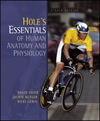 |  Hole's Essentials of Human Anatomy & Physiology, 8/e David N. Shier,
Washtenaw Community College
Jackie L. Butler,
Grayson County College
Ricki Lewis,
SUNY - Albany
Feature Summary| Hole's Essentials of Human Anatomy and Physiology is written with the student in mind.
Several features ease learning difficult concepts and terminology.
Chapter Objectives
Before beginning to study a chapter, carefully read the chapter objectives. These indicate what a
student should be able to do after mastering the information within the narrative. The review
exercises at the end of each chapter are phrased as detailed objectives, and reading them
before beginning to study is also helpful. Both the chapter objectives and the review exercises
are guides that identify important chapter topics.
Aids to Understanding Words
Aids to Understanding Words, found at the beginning of each chapter and in the appendix, help
build vocabulary. These sections define root words, stems, prefixes, and suffixes that help the
student discover word meanings, and then apply these definitions in example words. Studying
these lists will help with understanding and remembering scientific word meanings.
Key Terms and Pronunciations
A list of key terms and their phonetic pronunciations at the beginning of each chapter helps build
science vocabulary. The key terms are boldfaced, defined within the chapter, and followed
again by pronunciations when the term is first introduced. These terms are likely to be found in
subsequent chapters. The glossary at the end of the book explains phonetic pronunciations.
Chapter Opening Vignettes
The authors provide interesting and thought-provoking vignettes that introduce the chapter
topics. Check Your Recall Review Questions
This edition continues to have review questions at the ends of major sections in each chapter to
test understanding of the material just covered.
Design
The text design injects new life into the study of Anatomy and Physiology. Bright, bold, modern
colors are used throughout the feature boxes, tables, and chapter openers making them easy to
recognize.
Illustrations
The new art program is designed to support the text and beyond. Labels and legends go only as
far as the text itself. However, the detail of the figures is accurate enough to support more
detailed discussion if the instructor or the student chooses further investigation.
Facts of Life briefs are fun bits of A&P trivia information scattered
throughout the text adding a touch of wonder to chapter topics and concepts.
Boxed Information
Short paragraphs in colored boxes apply ideas and facts in the narrative to clinical situations.
Some boxes describe changes in body structure and function that result from disease.
Genetics Connections
Genetics Connection explores the molecular underpinnings of familiar as well as not-so-familiar
illnesses.
Topics of Interest
Longer boxes, entitled "Topic of Interest," discuss disorders, physiological responses to
environmental factors, and other topics of general interest.
ORGANization Illustrations
ORGANization illustrations, found at the end of selected chapters, conceptually link the
highlighted body system to every other system and reinforce the dynamic interplays between
groups of organs. These graphic representations stress the "big picture" in learning and applying
anatomy and physiology.
Clinical Connections
These new briefs are integrated at the end of several chapters to "pull the concepts together".
The short vignettes help students make a vital real-life connection to the chapter material.
Clinical Terms
At the end of many chapters are lists of related terms often used in clinical situations. These
terms, along with their phonetic pronunciations and brief definitions, are helpful to understanding
medical terminology.
Chapter Summaries
An end-of-chapter summary in outline form helps you review the chapter's main ideas.
Review Exercises and Critical Thinking
End-of-chapter review exercises check understanding of the chapter's major ideas. Critical
thinking questions, many of them new, coax you to apply information to clinical situations.
Web Connections
This end-of-chapter feature directs students to helpful online websites that will promote greater
understanding of chapter content.
Reference Plates
Reference plates continue to be a strong feature in this edition. One set illustrates the structure
and location of major internal organs. Its white background improves contrast, making the art
more vibrant and detail easier to see. Another set of reference plates depicts the structural detail
of the human skull. All reference plates have a colored tab down the length of the page for easy
access.
Unit and Chapter Tabs
Colored tabs on page edges highlight unit and chapter openers and provide easier reference.
|
|



 2003 McGraw-Hill Higher Education
2003 McGraw-Hill Higher Education